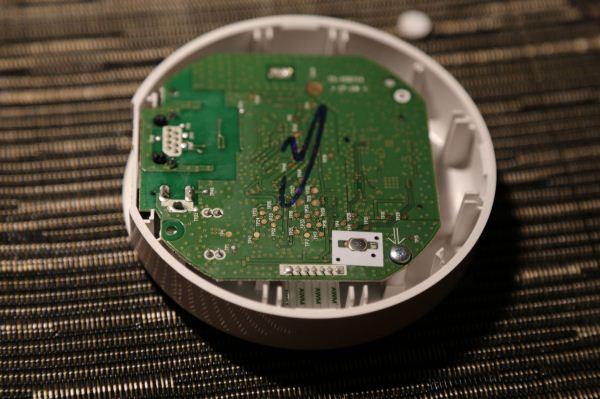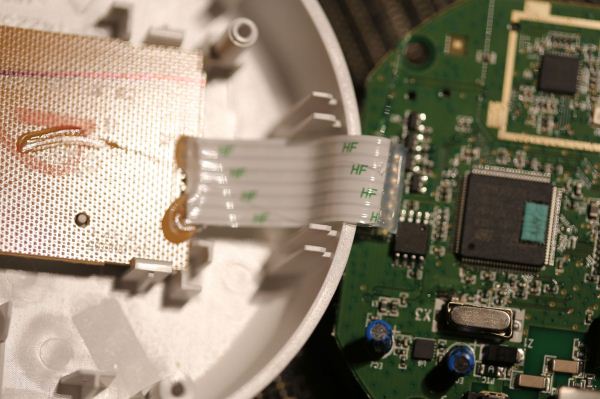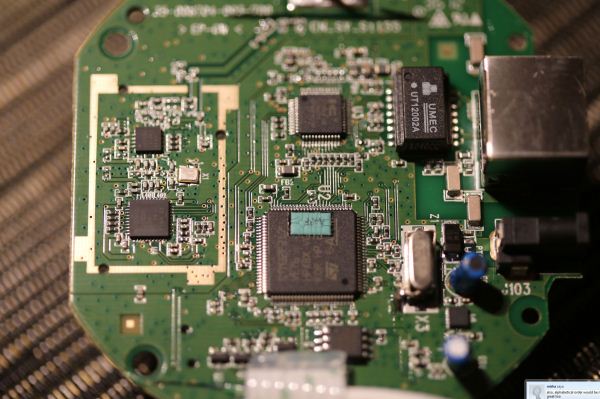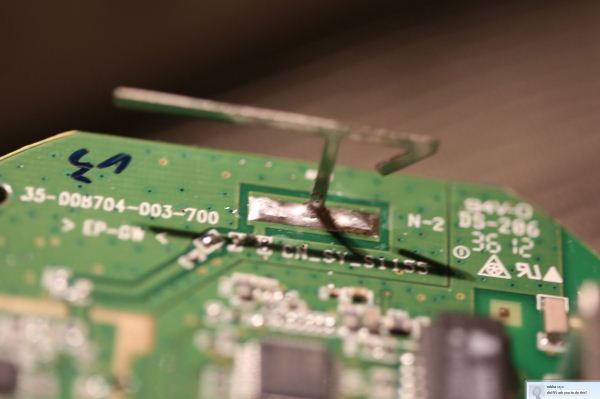Philips Hue: Automated Home Lighting Gets Colorful
by Ashu Joshi on March 1, 2013 12:50 AM EST- Posted in
- Gadgets
- Home Automation
- Philips
- Hue
- Lighting
Teardown and Design
The Hue Bridge has two screws that you need to remove before you can pop off the back. Even with the screws out, popping the back off is tricky—it has an interesting snap-in mechanism. Here’s what the back looks look like; the two white “feet” at the bottom are covering the screws. I used tools from iFixIt to get this open.
Once you open it up, you can see the back side of the PCB, and the snap-in connecter I mentioned earlier.
The PCB is connected to the front of the Bridge using a ribbon connector. This cable provides the power and signals for the LEDs and the Link button.
The main PCB has the two primary components of the Hue Bridge, an ST Microelectronics STM32F217VE Microcontrollerand a Texas Instruments CC2530 ZigBee Controller.
There is also an RF range extender (CC2590) coupled to the CC2530. The STM MCU has an integrated Ethernet controller, but as a whole the design has very few components. It’s clear that the majority of the cost for the Starter Pack is in the bulbs and not in the Bridge. (Based on the total kit price, the Bridge is $20 more than the cost of the three bulbs, though of course that leaves plenty of room for profit margins.) The image below shows the antenna for ZigBee:
I’ll cover the technology behind the Hue Bridge in a moment, but the choice of microcontroller for this design is a clear indication that this is primarily a purpose-built device. That is, it does not have the horsepower to extend to different types of applications due to the limitations of the CPU and the amount of memory. Nonetheless, it is well suited for the function at hand; let’s look at the specifics of the technology behind Hue before we get into a discussion of what it can and cannot do.





















94 Comments
View All Comments
WeaselITB - Friday, March 1, 2013 - link
They (Philips) have already demonstrated this technology with their Ambilight line of products -- http://www.research.philips.com/technologies/proje...-Weasel
Gunbuster - Friday, March 1, 2013 - link
Really confused why you would have a multiple page review and not include any pictures or video of the bulbs in action.jginnane - Friday, March 1, 2013 - link
We've installed extensive LED downlighting in our home using Cree LR6 and CR6 modules. The color temperatures for each are either 2700K (warm) or 3000K (cool).We also spent a month in China recently, and were surprised to find so few incandescent bulbs still in use. Residential lighting is practically 100% LED by now, from Chengdu to Shanghai. Only in places where the infrastructure was developed much earlier, like Hong Kong SAR, do you still find some "old" lighting fixtures.
The Philips controller system reviewed here is enjoyable for its novelty. But in day-to-day practice, you're going to keep a very narrow band of lighting (color and "temperature") for daily use: warm for morning and evening; cool for maximum efficiency in peak times. (Think of it as 100-watt bulbs in your living room versus fluorescents at work.) Barring extreme OCD, you're not going to dial spectrum changes up as more than a seasonal event.
So the automation/connectivity issue is about as important as putting wifi in your fridge or oven. (Not!) You are far more likely to be researching improvements in LED efficiency at your Home Depot or Lowes than maximizing the potential of your home lightbulb network.
degobah77 - Friday, March 1, 2013 - link
The purpose of the novelty is to take pictures of your decor, load it into the app, and match the color palette to your bulbs. It's primarily accent lighting if you ask me, but if needed can operate normally as you suggest, such as the preloaded Relax (warm, dim) or Concentrate (max white, bright) modes. Either way, I don't think Philips is marketing this for the Home Depot crowd, or for the LED efficiency aspect of it. These are just toys.jginnane - Friday, March 1, 2013 - link
It was on my third pass through the article that I found these bulbs are ""60-watt equivalent" -- determined by getting the maximum Kill-a-Watt draw, 5.4 watts, and "55-watt savings" touted later. So three Philips 60-watt bulb equivalents are nearly sufficient for low ambient lighting in a small room, not focused task lighting (like reading). (Claimed output my Philips of 600 lumens apiece.)Yes indeed -- unfortunately -- this Philips package just represents toys at this stage. Besides the high initial price of LED lights, other use considerations are max output and dimming ability. Many companies besides CREE and Philips did not have any dimming ability at all in their first-gen US consumer products. (Note that most LED + Lutron switch dimming combos only go down to about 20% power, then the LED modules start to "fizzle and spark" at lower power draws. If you have good existing wiring, like from incandescent cans you're replacing, you may have to progressively try lower-capacity dimmers because you're drawing maybe 20-40 watts in a room originally specified for 400-700 watts of incandescents.)
melgross - Friday, March 1, 2013 - link
Unfortunately, without having a lumen rating, that number isn't very useful. I find that it can vary all over the place. So that approximately 60 watt number can vary by 50%.degobah77 - Friday, March 1, 2013 - link
On Concentrate mode, I'd assert that the brightness is between a 60w-75w standard bulb, but closer to the 60. It's more than bright enough for reading. It's definitely not low ambient lighting at it's peak output, but it's also no where close to a 100w bulb. Those things burn my eyes anyway.But like I said, I don't think this particular product is designed for doing your entire house for a home improvement project, it's personal accent lighting for, dare I say, tech enthusiasts. I set moods and change colors frequently just because I can and it's fun. The deep purples and blues are room saturating. Great for parties and alerting your loved ones that you're just about to walk in the front door.
melgross - Friday, March 1, 2013 - link
I'd still like to see a lumen test done. I could do it, but I don't need this product, so I don't want to spend that much just for that.kmmatney - Friday, March 1, 2013 - link
My local Home Depot had the CR-6 at $25, so I bought 8 of them. I wish I bought more since the price is back up to $35. I need 27 of them to convert my whole house. The CR-6 is a much better deal is you have recessed lighting (vs. these Philips bulbs). I've been very happy with the CR-6, and like being able to finally have a dimmer in some of my rooms.BravoRomeo - Sunday, April 7, 2013 - link
Yes, the CREE CR-6 is excellent. Like the Hue, it uses a combination of different color LEDs to produce a smoother and fuller spectrum of light, so colors look richer... Quite similar to incandescent and halogen. Having a CRI (Color Rendering Index) greater than 90 is important to me. I never got used to the poor CRI of CFLs. A lot of the cheaper LEDs use single phosphor chip LEDs, which is not much of an improvement over CFLs.I have several CR-6s installed, and now I'm looking for similar quality for floor lamps and such. Hue is impressive, but added complexity. I'd really like something like Hue or the CR-6 that can truly emulate the incandescent bulb: the color should drift orange as the lamp is dimmed... Perhaps add a simple slide switch to enable that feature as well as choose cool, neutral, or warm color.